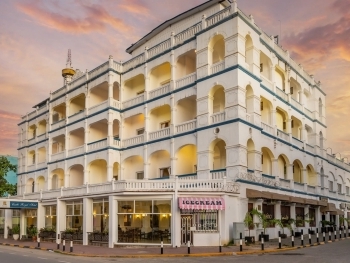Nestled on Sunset Boulevard in West Hollywood, California, Chateau Marmont is an iconic hotel that has stood the test of time, weaving itself into the fabric of Hollywood history. Since its opening in 1929, the hotel has been a sanctuary for celebrities, artists, and creatives, offering a blend of privacy, luxury, and an air of mystery. With its storied past, distinctive architecture, and a roster of illustrious guests, Chateau Marmont continues to be a symbol of old Hollywood glamour and contemporary chic.
Architectural Elegance and Beginnings
Chateau Marmont was conceived by Fred Horowitz, a Los Angeles attorney who envisioned a European-style apartment building in the heart of Hollywood. Inspired by the Château d'Amboise, a royal retreat in France's Loire Valley, Horowitz hired architect Arnold A. Weitzman to bring his vision to life. The result was a seven-story edifice that exuded French Gothic elegance, complete with turrets, steeply pitched roofs, and arched windows.
The building’s construction was completed in 1929, and it was initially intended as a luxury apartment complex. However, the Great Depression led to a decline in the real estate market, prompting Horowitz to convert the apartments into a hotel. Thus, Chateau Marmont was born, offering long-term accommodations for Hollywood's elite.
The Golden Age of Hollywood
From its inception, Chateau Marmont attracted the crème de la crème of Hollywood. The hotel's secluded and discreet nature made it an ideal refuge for stars seeking privacy away from the prying eyes of the paparazzi. In the 1930s and 1940s, it became a favored haunt of silver screen icons like Greta Garbo, Clark Gable, and Jean Harlow.
One of the most famous anecdotes from this era involves actor Jean Harlow, who, according to legend, spent her honeymoon at the hotel. Other notable guests included Howard Hughes, who rented a room for his various romantic liaisons, and F. Scott Fitzgerald, who resided at the hotel during a turbulent period of his life. These stories contributed to the mystique and allure of Chateau Marmont, cementing its reputation as a retreat for the stars.
The Rock 'n' Roll Era
The 1960s and 1970s saw Chateau Marmont transform into a sanctuary for the burgeoning rock 'n' roll scene. Musicians and bands found the hotel to be a perfect hideaway for both relaxation and excess. Jim Morrison of The Doors famously stayed at the hotel, where he purportedly hung from a drainpipe, adding to the hotel’s lore of wild and unpredictable behavior.
In the late 1970s, Chateau Marmont became a temporary home for Led Zeppelin, whose members were known for their debaucherous lifestyle. John Bonham, the band's drummer, allegedly rode a motorcycle through the hotel’s hallways. This period solidified the hotel's image as a rock 'n' roll haven, where anything could happen and often did.
A Renaissance in the 1980s and 1990s
As Hollywood evolved, so did Chateau Marmont. The 1980s and 1990s marked a renaissance for the hotel, attracting a new generation of stars and artists. Actor and comedian John Belushi’s tragic death from a drug overdose in one of the hotel’s bungalows in 1982 cast a shadow over its glamorous image, but also contributed to its enigmatic reputation.
During this time, Chateau Marmont became a favorite spot for film shoots and fashion photography, further embedding it in popular culture. The hotel was featured in movies such as "The Doors" (1991) and "Almost Famous" (2000), and its distinctive silhouette became synonymous with Hollywood itself.
The Modern Era: A Blend of Old and New
In the 21st century, Chateau Marmont has retained its allure while adapting to contemporary tastes. Under the ownership of hotelier André Balazs since 1990, the hotel has undergone renovations to preserve its historic charm while offering modern amenities. Balazs has maintained the delicate balance between the hotel’s storied past and its current status as a luxury destination.
Celebrities like Leonardo DiCaprio, Sofia Coppola, and Lindsay Lohan have been spotted at the hotel, continuing the tradition of high-profile guests. Chateau Marmont’s Bar Marmont and its restaurant have become hotspots for the Hollywood elite, known for their intimate and exclusive atmosphere.
Cultural Impact and Legacy
Chateau Marmont's cultural impact extends beyond its walls. It has inspired songs, films, and literature, symbolizing the intersection of glamour, creativity, and excess. The hotel’s reputation for discretion has made it a trusted haven for stars seeking respite from public scrutiny.
In recent years, the hotel has faced challenges, including a controversial transition to a private members-only club in 2020, a move met with mixed reactions. Despite this, Chateau Marmont’s legacy as a Hollywood icon remains intact, representing nearly a century of history and the ever-changing landscape of the entertainment industry.
Chateau Marmont stands as a testament to Hollywood's evolution, embodying the spirit of the entertainment industry in all its glory and complexity. Its walls have witnessed the rise and fall of stars, the creation of timeless art, and the ebb and flow of cultural trends. As it continues to adapt and thrive, Chateau Marmont remains an indelible part of Hollywood’s past, present, and future, a place where legends are made and stories are born.












